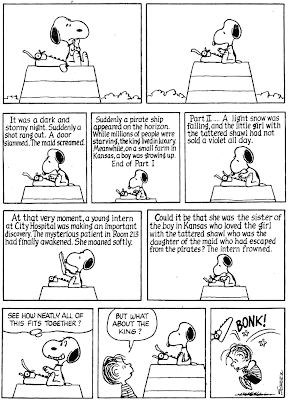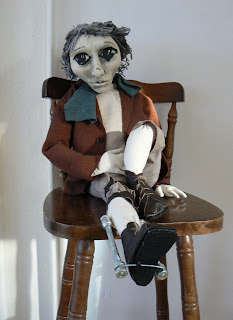 Rehearsals for my new stage adaptation of Charles Dickens' immortal tale, A Christmas Carol continue apace in preparation for next Tuesday's opening night.
Rehearsals for my new stage adaptation of Charles Dickens' immortal tale, A Christmas Carol continue apace in preparation for next Tuesday's opening night.Some people -- many, even -- may ask: "What? Yet Another Christmas Carol?"
True, Dickens' seasonal classic is so well-known that it has become part of popular mythology, like a folk-tale that is perennially retold and endlessly reworked in the telling.
Even people who have never read the book, actually believe they have! Just say the word “Humbug!”, and people think of Ebenezer Scrooge; utter the phrase: “God bless us, every one!” and they immediately recall the words of Tiny Tim.
It's got apparitions, transformations and all manner of imaginative scenes from the frenzied delights of a Christmas ball to ghostly goings-on in a graveyard.

A Christmas Carol might almost have been written for the stage and it's certainly been on stage somewhere or other in the world during every one of the 164 years since the book’s publication.
It was in December 1843 that Dickens novella made its appearance and, within weeks, there were no fewer than eight dramatised versions of the story being simultaneously presented on the London stage!
There was one version billed as A Christmas Carol, or the Miser's Warning and another bearing the epic title, A Christmas Carol, or Scrooge the Miser's Dream, or, The Past, Present, and Future. Hardly any of them could be described as being entirely faithful to the original and not a single one paid so much as a penny to the author.

One of the first actors to portray Scrooge was a celebrated Victorian thespian called Mr O Smith, whose performance was described by Dickens as “drearily better than I expected”, adding that he found it “a great comfort to have this kind of meat underdone”,' something which can hardly be said of many of his successors!
A long and distinguished line of actors have portrayed the “squeezing, wrenching, grasping, scraping, clutching, covetous old sinner” and 'Scrooging' has been a particularly popular pastime among the knights of the theatre with spirited performances, over the years, from Laurence Olivier, Ralph Richardson, John Gielgud, Alec Guinness and Michael Hordern.
 Theatrical veterans Bransby Williams and Seymour Hicks both played the part first in legitimate theatrical productions, then turned their performances into solo music hall acts and eventually became two of the earliest screen Scrooges, succeeded by the likes of Alistair Sim, Albert Finney, Michael Caine and George C Scott.
Theatrical veterans Bransby Williams and Seymour Hicks both played the part first in legitimate theatrical productions, then turned their performances into solo music hall acts and eventually became two of the earliest screen Scrooges, succeeded by the likes of Alistair Sim, Albert Finney, Michael Caine and George C Scott.Indeed there always seems to be a new film-version in the offing - the most recent of which, slated for 2009, will feature Jim Carrey.
Every conceivable medium has been employed in telling Dickens’ story from a mime by Marcel Marceau to an opera sung by Sir Geraint Evans and there have been Ebenezer Scrooges for every possible taste: from the senior partner of Steptoe and Son, Wilfred Brambell, to the captain of the Starship Enterprise, Patrick Stewart; not to mention musical versions starring Anthony Newley and Tommy Steele.
In America, where A Christmas Carol is equally beloved, Dickens' stonyhearted skinflint was portrayed on wireless for many years by Lionel Barrymore and elsewhere by Orson Welles, Basil Rathbone, Frederick March, Ronald Colman and Kelsey Grammer.
 Everyone, of course, loves the Muppets’ take on the story, with Kermit and Miss Piggy as Bob and Mrs Cratchit and the Great Gonzo’s unforgettable impersonation of Charles Dickens; but there have been many other animated Carols featuring an interesting role-call of cartoon Scrooges ‘played’ by Mr Magoo, Fred Flintstone, Yosemite Sam and Donald Duck's penny-pinching uncle, Scrooge McDuck!
Everyone, of course, loves the Muppets’ take on the story, with Kermit and Miss Piggy as Bob and Mrs Cratchit and the Great Gonzo’s unforgettable impersonation of Charles Dickens; but there have been many other animated Carols featuring an interesting role-call of cartoon Scrooges ‘played’ by Mr Magoo, Fred Flintstone, Yosemite Sam and Donald Duck's penny-pinching uncle, Scrooge McDuck!In fact, there has always been a generous supply of odd-ball versions including a couple of female incarnations of Scrooge and Americanised retellings and updatings with the likes of Henry Winkler, Bill Murray and, in an all-black musical, Gregory Hines portraying Scrooge as the landlord of a Harlem slum.
Despite the existence so many dramatisations of Dickens’ “ghost story of Christmas”, few of them have managed to find a way of retaining the highly personal and strongly present authorial voice.
Of all the memorable characters and events in Dickens’ prodigious literary output, those in this little tale - written in response to the terrible poverty of his day - were created with white-hot zeal and human compassion.
This is one of the reasons why this book has always been so beloved by generations of readers: Dickens the man is heard not just in his wonderful descriptions evoking the rituals of Christmas, but also in the storyteller's intense emotional involvement with the business of saving Scrooge’s soul.

 It was this aspect of the book that I most wanted to preserve in dramatising it anew.
It was this aspect of the book that I most wanted to preserve in dramatising it anew.As a result, Dickens (himself a talented amateur actor and a celebrated performer of his own works, right) physically becomes part of the telling of the story: not simply as a narrator, but as a character - a convivial host, puppet-master and conjuror - setting the scene, introducing a vast cast of characters (portrayed by a relatively small ensemble group) and leading his audience through the curious events of an unforgettable Christmas Eve...
Reviewing A Christmas Carol in 1843, William Makepeace Thackeray wrote: “It seems to me a national benefit, and to every man and woman who reads it a personal kindness.”
Over of a century-and-a-half later, there still seems no reason to quibble with that verdict.











 Following on from my posting of one of many favourite Peanuts strips the other day, I should mention that I've been reading David Michaelis'
Following on from my posting of one of many favourite Peanuts strips the other day, I should mention that I've been reading David Michaelis' 




























